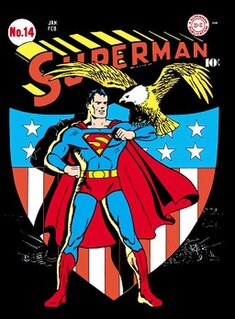
The Golden Age of Comic Books describes an era of American comic books from 1938 to 1956. During this time, modern comic books were first published and rapidly increased in popularity. The superhero archetype was created and many well-known characters were introduced, including Superman, Batman, Robin, Shazam, Captain America, and Wonder Woman.

Timely Comics is the common name for the group of corporations that was the earliest comic book arm of American publisher Martin Goodman, and the entity that would evolve by the 1960s to become Marvel Comics.

All-American Comics was a comics anthology and the flagship title of comic book publisher All-American Publications, one of the forerunners of DC Comics. It ran for 102 issues from 1939 to 1948. Characters created for the title, including Green Lantern, the Atom, the Red Tornado, Doctor Mid-Nite, and Sargon the Sorcerer, later became mainstays of the DC Comics line.

Miss Victory is an American superheroine who first appeared in Captain Fearless #1, published by Frank Z. Temerson's Helnit Publishing Co. Ceasing to be published after 1946, she was revived and updated in 1984 as a central character in the Femforce comic-book series published by A.C. Comics.

Flash Comics is a comics anthology published by All-American Publications and later by National Periodical Publications. The title had 104 issues published from January 1940 to February 1949. Despite the title, the anthology featured the adventures of multiple superheroes in addition to Jay Garrick, the original Flash. Characters introduced in the series include the Flash, Hawkman, Hawkgirl and Black Canary.

Iron Man and Sub-Mariner is a one-shot comic book published by Marvel Comics in 1968. It is notable for being the first Marvel title to be intentionally published for only one issue, as it existed to use up two half-length stories left over after Marvel began its expansion and the characters were to be given their own solo titles.
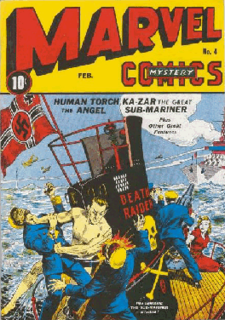
Marvel Mystery Comics is an American comic book series published during the 1930s–1940s period known to fans and historians as the Golden Age of Comic Books. It was the first publication of Marvel Comics' predecessor, Timely Comics, a division of Timely Publications.

Miss America is a superhero appearing in American comic books published by Marvel Comics. She first appeared in Marvel Mystery Comics #49, and was created by writer Otto Binder and artist Al Gabriele for Timely Comics, the 1940s precursor of Marvel, in the period fans and historians call the Golden Age of Comic Books.

Black Widow is a fictional character appearing in American comic books published by Marvel Comics. Claire Voyant is a medium who is murdered and becomes "Satan's ambassador" on Earth, killing evildoers in order to deliver their souls to her master. She first appears in Mystic Comics #4, published by Marvel predecessor Timely Comics. Created by writer George Kapitan and artist Harry Sahle, she is unrelated to Marvel's later superspy character called Black Widow.
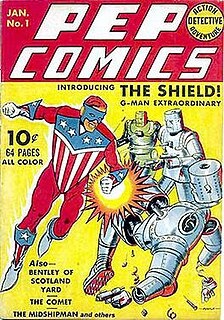
The Shield is the name of several superheroes created by MLJ. Appearing months before Captain America, the Shield has the distinction of being the first superhero with a costume based upon United States patriotic iconography. The character appeared in Pep Comics from issue #1 to #65.
Carl Burgos was an American comic book and advertising artist best known for creating the original Human Torch in Marvel Comics #1, during the period historians and fans call the Golden Age of comic books.

Vision (Aarkus) is a fictional superhero appearing in American comic books published by Marvel Comics. Created by the writer Joe Simon and artist Jack Kirby, the character first appeared during the Golden Age of comic books in Marvel Mystery Comics #13, published by Marvel predecessor Timely Comics.

Korak, a fictional character, is the ape name of John "Jack" Clayton III, the son of Tarzan and Jane Porter.
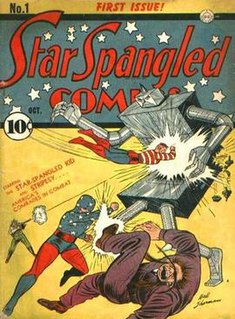
Star Spangled Comics was a comics anthology published by DC Comics which ran for 130 issues from October 1941 to July 1952. It was then retitled Star Spangled War Stories and lasted until issue #204.

The Liberty Legion is a fictional superhero team appearing in American comic books published by Marvel Comics. The team was first created in 1976 and set during World War II. Composed of existing heroes from Marvel's 1940s Golden Age of Comic Books predecessor, Timely Comics, the team was assembled and named by writer Roy Thomas in a story arc running through The Invaders #5–6 and Marvel Premiere #29–30. Inspired by the Liberty Legion, a second fictional team called the Liberteens was published in 2007 as part of the Avengers Initiative.
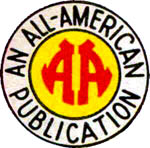
All-American Publications was one of two American comic book companies that merged to form the modern day DC Comics, one of the two largest publishers of comic books in the United States. Superheroes created for All-American include the original Atom, Flash, Green Lantern, Hawkman, and Wonder Woman, all in the 1940s' Golden Age of Comic Books.

Crestwood Publications, also known as Feature Publications, was a magazine publisher that also published comic books from the 1940s through the 1960s. Its title Prize Comics contained what is considered the first ongoing horror comic-book feature, Dick Briefer's "Frankenstein". Crestwood is best known for its Prize Group imprint, published in the late 1940s to mid-1950s through packagers Joe Simon and Jack Kirby, who created such historically prominent titles as the horror comic Black Magic, the creator-owned superhero satire Fighting American, and the first romance comic title, Young Romance.
Al Gabriele (deceased) was an American comic book artist during the 1940s period fans and historians call the Golden Age of comic books. He is known for his work on some of Marvel Comics' earliest Captain America and Sub-Mariner stories, and for co-creating the company's superheroes Black Marvel, Miss America, and possibly, the Whizzer.
Richard Briefer was an American comic-book artist best known for his various adaptations, including humorous ones, of the Frankenstein monster. Under the pseudonym Dick Hamilton, he also created the superhero team the Target and the Targeteers for Novelty Press.
Harry Frank Sahle was an American comic book artist who drew for such publishers as Archie Comics—helping create the defined look of Archie Comics' breakout character, Archie Andrews—Quality Comics and the Marvel Comics precursor company Timely Comics during the 1930s-1940s period historians and fans call the Golden Age of Comic Books.
















